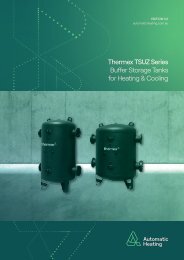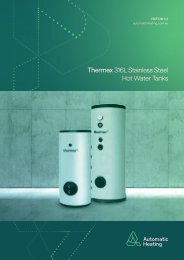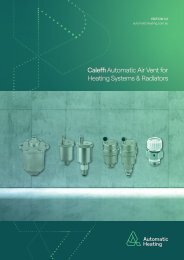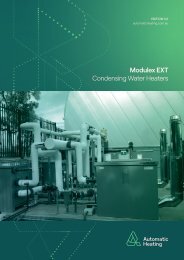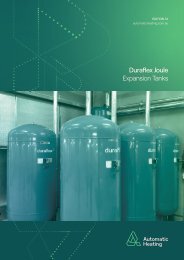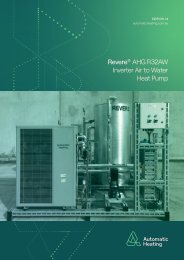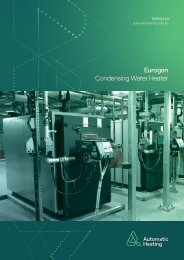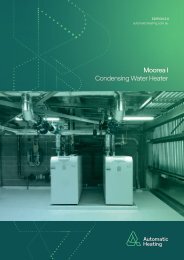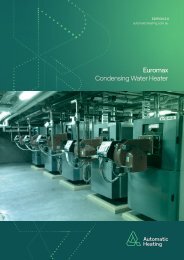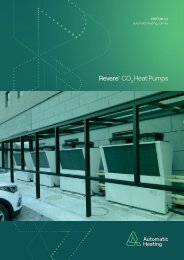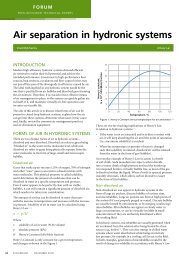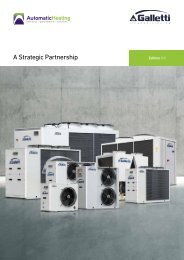AHG Solutions Guide_Edition 2.7
Full Product and Solutions Guide - Automatic Heating Global Pty Ltd
Full Product and Solutions Guide - Automatic Heating Global Pty Ltd
You also want an ePaper? Increase the reach of your titles
YUMPU automatically turns print PDFs into web optimized ePapers that Google loves.
Expansion Tanks & Pressurisation Systems<br />
Contents<br />
Expansion Tank Sizing,<br />
Commissioning & Maintenance<br />
Sizing an Expansion Tank<br />
Careful calculation of the expansion tank size is critical to the correct functioning of the system.<br />
Expansion Coefficient<br />
Calculate the expansion coefficient for your system by calculating the difference between the cold<br />
system water temperature (heating off) and the max working temperature.<br />
ºC Coefficient<br />
6<br />
0 0.00013<br />
EXPANSION &<br />
DEAERATION<br />
10 0.00025<br />
20 0.00174<br />
30 0.00426<br />
40 0.00782<br />
50 0.01207<br />
60 0.0145<br />
65 0.01704<br />
70 0.0198<br />
75 0.02269<br />
80 0.0258<br />
85 0.02899<br />
90 0.0324<br />
95 0.0396<br />
100 0.04343<br />
% Expansion<br />
5<br />
4<br />
3<br />
2<br />
1<br />
0<br />
0 10 20 30 40 50 60 70 80 90 100 110 120<br />
Water Temperature ºC<br />
Heating System<br />
The expansion tank sizing formula is as follows:<br />
(based on Boyles Law)<br />
Cooling System<br />
The vessel sizing formula is as follows:<br />
(based on Boyles Law)<br />
e x C<br />
Vt = 1 - (Pi/Pf) =<br />
Vu<br />
1 - (Pi/Pf)<br />
Vt =<br />
e x C<br />
1 - (Pi/Pf)<br />
where:<br />
Vu =<br />
Total useful volume of tank = Vi - Vf<br />
Vi = Initial volume<br />
Vf = Final volume<br />
e = Expansion coefficient<br />
Pi = Initial charge pressure (absolute) of vessel.<br />
This pressure must not be lower than the hydrostatic pressure at the point<br />
where the tank is connected to the system.<br />
Pf = Maximum operating pressure (absolute) of the<br />
relief (safety) valve<br />
taking into account any differences in level between the vessel<br />
and the safety valve.<br />
C = Total water capacity of the system in litres:<br />
boiler, pipework, radiators etc<br />
(as a general approximation, C is between 4 and 8 litres<br />
for every kW of boiler output)<br />
Note: Calculations must be done in Absolute Pressure<br />
e.g. 100kPa = 200kPa absolute.<br />
In standard heating systems:<br />
e = 0.04318 (Tmax = 99°C, Tmin = 10°C, Δt = 89ºC, C = 0.035)<br />
In standard cooling systems:<br />
e = 0.011 (Tmax = 50ºC, T min =4ºC)<br />
Pi = Maximum plant pressure, corresponding to the maximum<br />
achievable temperature, equal to the ambient temperature,<br />
which is recommended to be fixed at 50ºC<br />
Pf = The final working pressure achieved at minimum<br />
temperature, using 4ºC<br />
Example<br />
C = 500 litres<br />
Pi = 150kPa (250kPa Abs)<br />
Pf = 400kPa (500kPa Abs)<br />
V = 0.04318 x 500 = 43.2 litres<br />
1 - (250/500)<br />
Select the next largest sized tank 50 litres<br />
168



